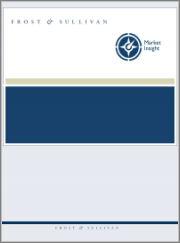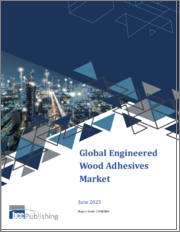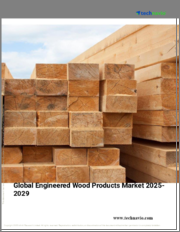
|
시장보고서
상품코드
1385548
세계의 엔지니어드 우드 성장 기회Global Engineered Wood Growth Opportunities |
||||||
건축 부문과 지속가능성 트렌드로 미래 성장 잠재력 확보
이번 조사에서는 엔지니어드 우드 제품(합판, 배향성 스트랜드보드(OSB), LVL, 크로스 라미네이트(CLT), 중밀도 및 고밀도 섬유판(MDF, HDF), 파티클보드(또는 칩보드), 집성재(글루램, 하드보드) 및 접착제(멜라민 우레아, 하드보드 등)를 대상으로 하고, 파티클보드(또는 칩보드), 집성재(글루램, 하드보드) 및 접착제(멜라민-우레아-포름알데히드(MUF), 페놀 수지, 우레아-포름알데히드(UF), 메틸렌디페닐디이소시아네이트(MDI) 수지 등)입니다.
용도별로 엔지니어드 우드는 건축용, 가구용(가구, 캐비닛, 몰딩, 선반), 포장용, 기타(항해용, 기차 장비, 목제 장난감)로 구분됩니다. 지역별로는 북미와 남미, 유럽, 중동 및 아프리카 SA(아프리카, 서아시아, 남아시아), 아시아태평양(오세아니아, 중앙아시아, 동아시아, 동남아시아)으로 나뉩니다.
이 연구는 각 용도 및 지역별 엔지니어드 우드 제품별 시장 역학에 대해 심층적으로 분석하여 엔지니어드 우드 제품 및 바인더의 수익과 물량을 예측합니다.
엔지니어드 우드의 수요는 최종 산업(건축, 가구)의 성장에 의해 주도될 것이며, 엔지니어드 우드는 점차 건축 자재를 대체할 것으로 보입니다. 그러나 재료 강도의 감소는 이러한 성장을 둔화시킬 것으로 보입니다. 엔지니어드 우드 제품 가격은 극심한 기후 변화, 수요를 주도하는 지속가능성 트렌드, 에너지 가격 상승 등 여러 요인에 의해 상승할 것으로 보입니다.
접착제 수량은 엔지니어드 우드 시장으로 인해 증가하고, 응용 기술의 효율성과 기술 개선으로 인해 감소할 것으로 보입니다. 가격은 지난 몇 년 동안 큰 변동을 겪었으며 가까운 장래에 계속 상승할 것으로 예상됩니다.
성장 기회 측면에서 볼 때, 대량 목재는 건설 분야에서 계속 성장하고 있으며, 이러한 용도의 고성능 접착제가 그 뒤를 잇고 있는 것으로 분석됩니다. 또한, 포름알데히드 배출 규제가 강화되면서 바이오 기반 접착제가 그 입지를 다지고 있습니다.
목차
전략적 과제
- 왜 성장이 어려워지고 있는지?
- The Strategic Imperative 8(TM)
- 엔지니어드 우드 업계의 전략적 과제 탑 3의 영향
- 성장 기회가 Growth Pipeline Engine(TM)
성장 기회 분석 - 엔지니어드 우드
- 분석 범위
- 시장 세분화와 용도
- 엔지니어드 우드 제품에 사용되는 목재와 접착제
- 약어와 정의
- 정의
- 주요 경쟁사
- 성장 지표
- 엔지니어드 우드 공급망
- 성장 촉진요인
- 성장 촉진요인 분석
- 성장 저해요인
- 성장 저해요인 분석
- 예측 가정
- 매출과 수량 예측
- 매출과 수량 예측 분석
- 엔지니어드 우드 제품 특징과 개요
- 제품 유형별 매출과 수량 예측
- 제품 유형별 수량 전망
- 용도별 수량 구성비
- 제품 유형별·용도별 수량 예측
- 지역별 수량 비율
- 지역별 수량
- 가격 동향과 예측
- 경쟁 환경
- 시장 점유율
- 엔지니어드 우드 시장 주목 기업과 혁신적 솔루션
- 엔지니어드 대나무
- 엔지니어드 헴프
- 사례 연구 - Tomra
성장 기회 분석 - 엔지니어드 우드 산업의 접착제
- 접착제 - 부문 특징과 개요
- 제품 유형별 접착제
- 엔지니어드 우드 산업의 주요 접착제
- 바이오 기반 접착제
- 엔지니어드 우드용 에코 접착제 - 주목 기업
- 성장 지표
- 성장 촉진요인
- 성장 촉진요인 분석
- 성장 저해요인
- 성장 저해요인 분석
- 성장 촉진요인과 억제요인이 접착제 시장에 미치는 영향
- 매출과 수량 예측
- 매출과 수량 예측 분석
- 제품별 매출과 수량 예측
- 제품별 수량 예측
- 가격 동향 예측
성장 기회 유니버스
- 성장 기회 1 - 건축의 대량 목재
- 성장 기회 2 - 대량 목재용 고성능 접착제
- 성장 기회 3 - 모듈러 구조
- 성장 기회 4 - 엔지니어드 우드용 바이오 기반 접착제
- 성장 기회 5 - 혁신적인 엔지니어드 우드 용도
부록
- 엔지니어드 우드 업계의 주요 접착제(정보 출처)
- 바이오 기반 접착제 섹션(정보 출처)
다음 스텝
- 다음 스텝
- 왜 Frost인가, 왜 지금인가?
- 전시회 리스트
- 면책사항
Building Sector and Sustainability Trends Ensure Future Growth Potential
This study covers engineered wood (EW) products (including plywood, oriented strand board (OSB), laminated veneer lumber (LVL), cross-laminated timber (CLT), medium- and high-density fiberboard (MDF, HDF), particleboard (or chipboard), glued laminated timber (glulam), and hardboard) and bonding agents (including melamine-urea-formaldehyde (MUF), phenolic resin, urea-formaldehyde (UF), and methylene diphenyl diisocyanate (MDI) resin).
By application, EW volumes are segmented into construction, joinery (furniture, cabinetry, moldings, shelves), packaging, and others (nautical uses, equipment for trains, wooden toys). By region, the market is split into the Americas, Europe, MEASA (Africa, Western Asia, and Southern Asia), and APAC (Oceania, Central Asia, Eastern Asia, and Southeast Asia).
The study dives deep into market dynamics for each EW product in each application and each region, forecasting revenue and volume for them as well as for binding agents.
EW demand will be driven by end-industry (construction, joinery) growth, with EW gradually replacing construction materials. However, a reduction in material intensity will moderate this growth. EW product prices will be pushed up by several converging factors, such as extreme climate events, sustainability trends driving demand, and rising energy prices.
Bonding agent volume will be driven up by the EW market and down by improvements in efficiency and technologies in application technologies. Prices have suffered great volatility in the last few years and are expected to keep rising in the near future.
In terms of growth opportunities, the analysis shows that mass timber will keep growing in the construction sector, and high-performance adhesives for these applications will follow. Moreover, bio-based adhesives are finding their place among the increasing restrictions for formaldehyde emissions.
Table of Contents
Strategic Imperatives
- Why is it Increasingly Difficult to Grow?
- The Strategic Imperative 8™
- The Impact of the Top 3 Strategic Imperatives on the Engineered Wood (EW) Industry
- Growth Opportunities Fuel the Growth Pipeline Engine™
Growth Opportunity Analysis-Engineered Wood
- Scope of Analysis
- Market Segmentation and Applications
- Wood and Adhesives Used in EW Products
- Acronyms and Definitions
- Definitions
- Key Competitors
- Growth Metrics
- EW Supply Chain
- Growth Drivers
- Growth Driver Analysis
- Growth Restraints
- Growth Restraint Analysis
- Forecast Assumptions
- Revenue and Volume Forecast
- Revenue and Volume Forecast Analysis
- Characteristics and Overview of EW Products
- Revenue Forecast by Product Type
- Volume Forecast by Product Type
- Percent Volume by Application
- Volume by Product Type and Application
- Percent Volume by Region
- Volume by Region
- Pricing Trends and Forecast
- Competitive Environment
- Market Share
- Companies to Watch and Innovative Solutions for the EW Market
- Engineered Bamboo
- Engineered Hemp
- Case Study-Tomra
Growth Opportunity Analysis-Bonding Agents in the EW Industry
- Bonding Agents-Segment Characteristics and Overview
- Bonding Agents by Type of Product
- Main Bonding Agents in the EW Industry
- Bio-based Bonding Agents
- Green Bonding Agents for EW-Companies to Watch
- Growth Metrics
- Growth Drivers
- Growth Driver Analysis
- Growth Restraints
- Growth Restraint Analysis
- Impact of Growth Drivers and Restraints on the Bonding Agent Market
- Revenue and Volume Forecast
- Revenue and Volume Forecast Analysis
- Revenue Forecast by Product
- Volume Forecast by Product
- Pricing Trends Forecast
Growth Opportunity Universe
- Growth Opportunity 1-Mass Timber in Construction
- Growth Opportunity 2-High-performance Adhesives for Mass Timber
- Growth Opportunity 3-Modular Construction
- Growth Opportunity 4-Bio-based Adhesives for EW
- Growth Opportunity 5-Innovative EW Applications
Appendix
- Main Bonding Agents in the EW Industry (Sources)
- Bio-based Bonding Agents Section (Sources)
Next Steps
- Your Next Steps
- Why Frost, Why Now?
- List of Exhibits
- Legal Disclaimer



















